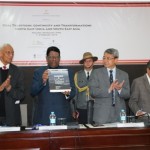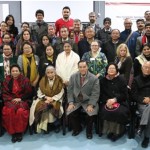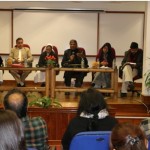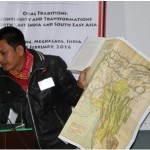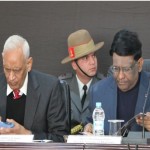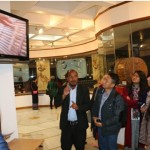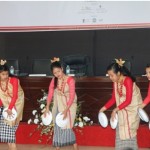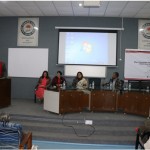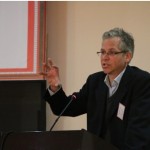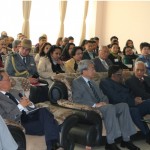Conference on ‘Oral Traditions: Continuity and Transformations, Northeast India and Southeast Asia, 1-4 February 2016, Shillong, Meghalaya Back
Conference on Oral Traditions: Continuity and Transformations – North East India and South East Asia
Shillong, Meghalaya, India, 1-4 February, 2016
Organised by
Intangible Cultural Heritage Division, Indian National Trust for Art and Cultural Heritage (INTACH)
and
The Centre for Community Knowledge, Ambedkar University Delhi (AUD)
A four-day conference was organized by ICH Division, in collaboration with the Centre for Community Knowledge, Ambedkar University on the theme of Oral Traditions: Continuity and Transformations, Northeast India and Southeast Asia at Shillong, Meghalaya from 1-4 February 2016. The conference brought together fifty scholars from five countries namely India, Thailand, Malaysia, UK and the Netherlands, along with heritage activists and museum curators belonging to local communities from the region. Delegates for the conference comprised of senior academicians, researchers and artists and practitioners from the field of cultural heritage.
The conference was inaugurated in the distinguished presence of Shri V. Shanmuganathan, Hon’ble Governor of Meghalaya, Maj Gen L.K. Gupta, Chairman INTACH, Shri P.B.O. Warjri, Chief Secretary, Meghalaya, Ambassador C. Rajasekhar, Director General, Indian Council for Cultural Relations, Shri Falguni Rajkumar, Chairman, Board of Governors, Rajiv Gandhi Indian Institute of Management, Shillong, Ms. Patricia Mukhim, Editor, The Shillong Times and Shri A.H. Scott Lyngdoh, Convener INTACH Meghalaya chapter. INTACH northeast conveners, Mr. Rohmingthanga, Ms. Pragya Deb Burman, Dr. R.K. Ranjan, Mr. P.K Dong and Ms. Sentila Yanger were also present.
The conference drew attention towards the dramatic cultural changes witnessed by the region in the last half of the century by organising an exhibition of photographs taken by one of the first major anthropologists who studied the region, Dr. Verrier Elwin. Another objective of this exhibition was to draw attention to the urgent need to preserve and digitize this photographic heritage of the northeastern region of India. The exhibition served as a visual document by providing insights into a critical period of transition.
The conference aimed to initiate a dialogue on how the communities in the northeast India have succeeded in safeguarding and transmitting their indigenous knowledge and practices in the presence of transformative social, political and ecological changes. The presentations ranged from sharing the field experience of working closely with these communities, to contextualising museum collections; tracing the population movements into India and the north eastern part of India, to providing insights into the clothing, food culture, social organisation, architectural specifications and rituals practiced in this region. Additionally, the presentations revealed certain similarities and/or adaptations in beliefs and practices emulated among each other, by the communities of northeast India and southeast Asia.
Each session was followed by a question/answer session which became a highly informative discussion in itself. The conference was structured as a combination of keynote addresses, research paper presentations, lecture demonstrations and panel discussions to enable a holistic understanding of the living cultures of northeast India. A curated walk of the Don Bosco Centre for Indigenous Cultures, followed by interactive sessions, presentations and experience-sharing by local community members, added to the knowledge-exchange process.
The deliberations and discussions held at the conference put forth multiple suggestions for project interventions, recommendations for safeguarding, preserving and promoting the ICH of northeast India, as well as maintaining the inter-linkages and other exchange systems between northeast India and southeast Asia, that have contributed to the vitality of ICH in these regions.
Concept
The North East of India is one of the least studied areas and continues to be seen as a region outside the larger Indian cultural framework. Set between China and India, the region is called a “shatter zone” by political and cultural geographers; a cultural area dominated by two or more strong neighbouring cultures. Located at the hub of concentric regional Cultural Zones, the NE indigenous and tribal tradition, as distinctive from tribal India as a whole, is a result of many processes, of cultural flows, migrations and movements of indigenous communities, and their local histories. The region has a special identity due to its isolation from South Asian tribal traditions, important geo-political influences that it has been subject to during the 19th and 20th centuries, and the advent of Christianity that brought with it education and community led reforms.
The connections between many aspects of Northeast Indian life and the larger Asian cultural landscape make sense when considered from a transnational perspective. However, current organization of academic knowledge is ill equipped to address such an approach. In order to contextualise the cultural, social and historical dynamics of the region, it is important to look beyond political boundaries, and highlight the cultural continuities in the larger region. This becomes important when the issues and concerns of understanding the multidimensional aspects of culture have been drawing the attention of contemporary scholars and policy makers across the world. This process is one way of reconsidering the manifestations of identities in the context of geographical continuity and cultural dynamics.
The need for a cultural mapping of the region, indicated by various academic and professional cultural institutions, emphasises the importance of collating the diversity of information, establish linkages between researchers and scholars, and promote communication between communities. Therefore, there is a need for intervention to provide wider regional – global applicability to cultural heritage and activities from the North East Region.
This Conference (1-4 February) and Exhibition of Photographs by Dr Verrier Elwin (1st February onwards) is being organized to highlight the cultural and historical linkages between communities of the region of North East India between each other and East and South East Asia. The interdisciplinary conference will bring together scholars, artists and organizations involved in the material and visual representation of this region. It will look specifically at living cultures – tangible and intangible– as transformations in the spheres of exchange and spheres of social value. Other areas include examination of cultural continuities in materials and crafts, social organisation, technological innovations and from oral traditions.
Objectives
- To scope present and past cultural connections among indigenous communities of Northeast India and Southeast Asia
- To understand how these indigenous communities retain cultural continuity by transforming knowledge and practice in the presence of social, political and ecological change
- To build on regional initiatives and community based practices in cultural heritage documentation and preservation in light of the above
- To address the above within the principles of the Shillong Charter
Themes
- 1. Transformations
- Ritual, tradition and history as reflection of movements and interactions, political and social changes
- Archaeological and historical resources – from beads to megaliths and rock art
- Genetic study of human diversity in the region and the ethics of engagement
- Linguistics and language continuities – mapping a cultural terrain
- Transmissions and Exchanges
- Borderlands in Oral Cultures – spatial representations, from orality and folklore to cartography and contemporary media
- Trade links and sites of exchange between Hills and Plains, across border contacts and exchange, nation state and the dislocation of tradition
- Observations on process and consequences, by looking at specific practices and cultural elements viz. food ways, costumes and clothing, ornamentation (including jewellery, tattoos and textiles), performative expressions, games and pastimes
- Safeguarding
- Intersections of indigenous landscape and modernity
- Landscapes, ecologies and cultural continuity, biodiversity knowledge systems – issues of community and individual ownership
- Heritage Tourism and Natural Heritage – connecting the intangible with the tangible
- Identity and community engagement with current cultural transformations
Shillong Conference Schedule 2016



